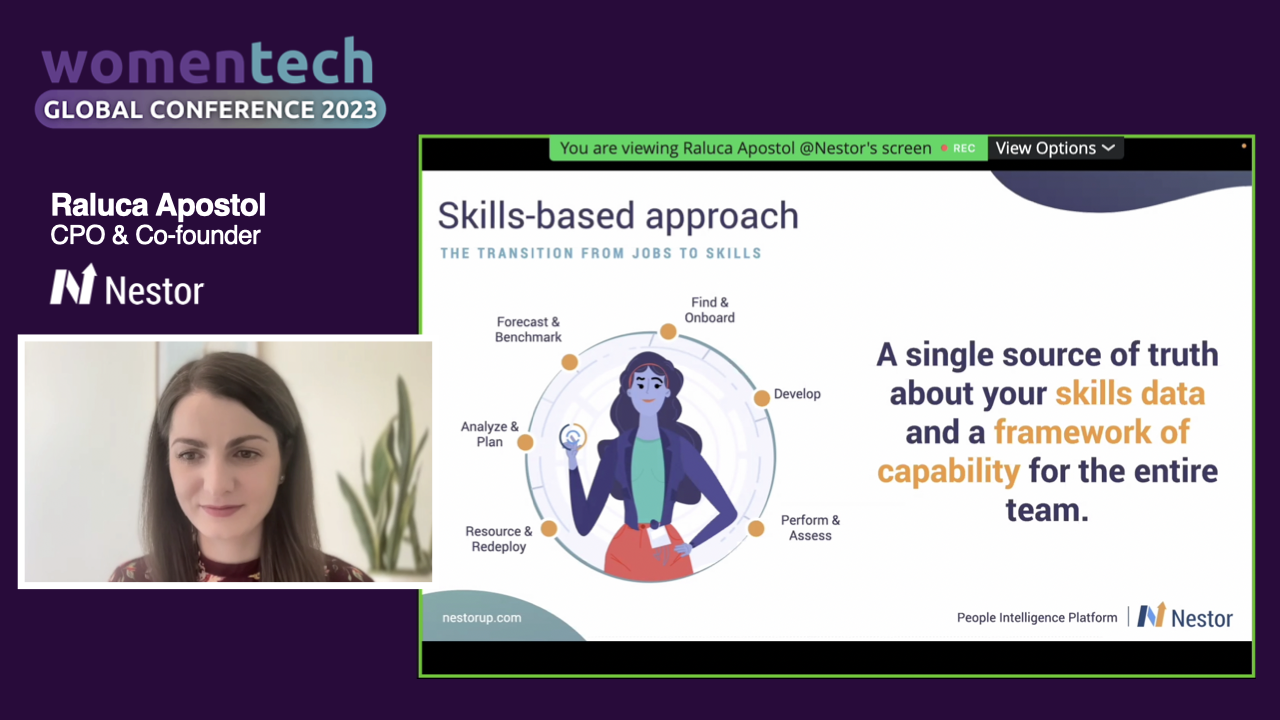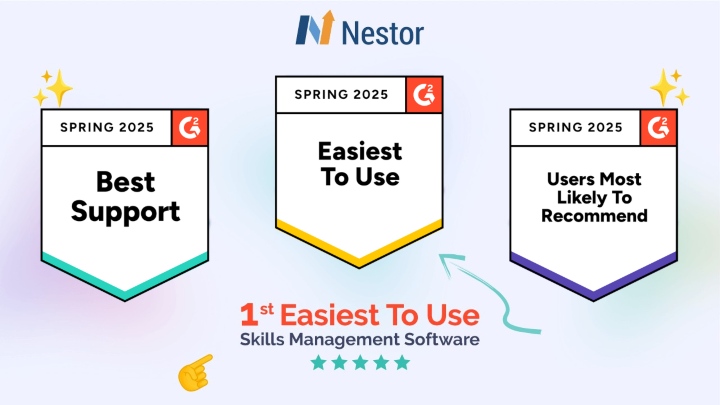Raluca Apostol, CPO and Co-founder of Nestor at WomenTech Global Conference 2023
6 min read

Our very own CPO, Raluca Apostol, who is also the co-founder of Nestor, shared her unique insights on skills taxonomies for software engineering teams during a talk that was part of the WomenTech Network Global Conference 2023.
While her presentation targeted a specific audience, the truth is the approaches, as well as the tips and tricks that were included, can be useful for HR departments and team leaders across various industries.
Insights on skills taxonomies
We live in a world where workplace expectations are changing, both for employees and employers. And to adapt and thrive in this new world, organizations should embrace a new skills-based approach:
1. Skills as a single source of truth
As we are moving from fixed job roles and requirements to skills-based teams and projects, companies will benefit enormously from having a clear overview of the real-time skills and knowledge of their workforce. These skills should be aligned with the framework of capabilities developed by each company.
The main benefits are:
- clarity and clear expectations among employees
- transparency over learning and development opportunities
- increased awareness among managers regarding the expertise within their teams

2. Skills taxonomy: processes and advantages
A skills taxonomy helps us gain confidence that our teams have the capabilities we need to be competitive in the market. While skills taxonomy has become a buzzword, the process itself, which involves identifying and quantifying skills can seem overwhelming. However, it is not so. All organizations need is a clear structure and a well-defined approach.
As Raluca pointed out, skills can be leveraged into a common language at work by using skills descriptions and proficiency levels everyone can relate to and further map titles with job expectations and with proficiency levels.
- Skill description (how we refer to it): a common and clear understanding of what the skill is and what it implies. This description should be very specific and used by everybody.
- Skill proficiency level (how we measure it): based on the specific needs (and industry) of each company, various criteria can be used to measure and define proficiency levels (e.g., beginner, intermediate, advanced, expert)

Let’s look at actual examples of soft skills required for software engineering teams, their definition, and at job expectations related to different proficiency levels for software developers:
#Example A. Problem-solving definition
Problem-solving is an in-demand skill in today’s world that refers to the process of achieving a goal by overcoming obstacles, which represent a frequent aspect of most (professional) activities. Problems in need of solutions range from simple, personal tasks to complex issues affecting entire teams or departments.
What problem-solving involves:
- defining the problem
- analyzing the problem
- identifying potential solutions
- evaluating the options
- selecting the best solution
- implementing it
- measuring the results
#Example B. Developer proficiency levels
- Junior developer (beginner): requires very specific and structured directions to achieve their goals
- Mid-level developer (intermediate): can work with minimal supervision and identify limitations in their old codebase
- Senior developer (advanced or proficient): doesn’t require any supervision and has the ability to anticipate and solve problems using existing or new approaches or tools
Some of the main advantages (for managers) of conducting a skills taxonomy include but aren’t limited to:
- Helps hire the best-fit candidates
- Helps them make the most out of the current abilities within their team
- Helps them offer internal growth and learning opportunities, which motivate people
3. Skills and hidden potential
Another reason why organizations should embrace a human-centric and skill-based approach is that it represents a paradigm shift. This new perspective allows them to see employees beyond their current competencies, job role, and responsibilities.
It allows people managers to find and develop untapped skills and help each worker reach their full potential.
It’s worth pointing out that the autonomy over development should be shared between managers (with business goals in mind) and employees, based on what they want to do, and the direction of their career (e.g., lateral or vertical move).
4. Skills-based profiles
Having a clear overview of all the unique skills, experience, and qualifications of each employee will give organizations an increased level of visibility. This will represent the basis for:
- a better understanding of the critical skills required for each role
- aligning workers and teams with the right projects
- quickly identifying areas for improvement
5. Identifying and assessing skills
Assessing abilities from multiple perspectives plays a crucial role in finding skills gaps and identifying areas where development programs are necessary. Different tools can be used during this process, including:
- self-assessment
- feedback from managers
- feedback from peers
To provide relevant insights, these tools should be aligned with the initial skills-based approach and take into account proficiency levels, areas for improvement, and whether (individual) expectations are met or exceeded.
6. Making better decisions based on skills
As the process of identifying and assessing skills becomes well-established and embraced by all teams, organizations will have the ability to use skills as the starting point for better data-driven decisions, even in areas beyond personalized growth plans for employees.
For instance, skills profiles can be connected to various other processes:
- performance reviews
- feedback and one-on-ones
- improving development efforts
- evolving the company culture
- strategic business expansion plans
About WomenTech Network
The WomenTech Network is specifically created to empower women in diverse roles across the technology industry, spanning from entry-level to top executive positions.
Its primary goal is to cultivate a nurturing community that encourages professional development and serves as a platform for inspiring more women to pursue careers in the tech sector.
Learn more about the WomenTech Network.
About Nestor
Nestor is the People Intelligence Platform that helps organizations unlock the Power of Skills to drive workforce agility, high performance, and continuous growth. Nestor connects performance management, employee engagement, and career development through a skills-based approach to help HR and business leaders make talent decisions aligned with the changing business needs.
Our technology uses predictive analytics and nudging automation to empower employees to take ownership of their careers, identify skills gaps, access growth opportunities, get involved in cross-functional initiatives and learn the skills that will help them succeed.
With a 98% adoption rate, Nestor is trusted by HR and people leaders in mid-to-large enterprises, including F500 companies, across the US, Latin America, and Europe.










